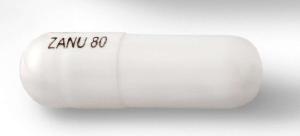Brukinsa Disease Interactions
There are 6 disease interactions with Brukinsa (zanubrutinib).
Zanubrutinib (applies to Brukinsa) arrhythmias
Moderate Potential Hazard, Moderate plausibility. Applicable conditions: Hypertension, Infection - Bacterial/Fungal/Protozoal/Viral, Heart Disease
Serious cardiac arrhythmias have been reported with zanubrutinib. Atrial fibrillation and atrial flutter have occurred in patients treated with zanubrutinib monotherapy. Care should be exercised when using this agent in patients with cardiac risk factors, hypertension, and acute infections as they may be at increased risk of cardiac arrhythmias. It is recommended to monitor for signs/symptoms of cardiac arrhythmias, manage appropriately, and consider the risks and benefits of continued treatment with zanubrutinib.
Zanubrutinib (applies to Brukinsa) bleeding
Moderate Potential Hazard, Moderate plausibility. Applicable conditions: Bleeding Associated with Coagulation Defect
Fatal and serious hemorrhage have occurred in patients with hematological malignancies treated with zanubrutinib monotherapy. Bleeding has occurred in patients with and without concomitant antiplatelet or anticoagulation therapy. Special care should be taken when this agent is coadministered with antiplatelet or anticoagulant medications as coadministration may further increase the risk of hemorrhage. It is recommended to monitor for signs/symptoms of bleeding and to discontinue zanubrutinib if intracranial hemorrhage of any grade occurs. The benefit-risk of withholding zanubrutinib for 3 to 7 days before and after surgery (depending on the type of surgery and the risk of bleeding) should be considered.
Zanubrutinib (applies to Brukinsa) cytopenias
Moderate Potential Hazard, Moderate plausibility. Applicable conditions: Bone Marrow Depression/Low Blood Counts
Cytopenias (including neutropenia, thrombocytopenia, and anemia [based on laboratory measurements]) were reported in patients treated with zanubrutinib monotherapy. Care should be taken when using this agent in patients with hematological abnormalities. It is recommended to monitor complete blood counts during therapy and interrupt treatment, reduce the dose, or discontinue zanubrutinib as warranted. Growth factor or transfusions should be used as treatment, as needed.
Zanubrutinib (applies to Brukinsa) hepatic impairment
Moderate Potential Hazard, Moderate plausibility. Applicable conditions: Liver Disease
The safety of zanubrutinib has not been evaluated in patients with severe liver dysfunction (Child-Pugh C); dosage modification of zanubrutinib is recommended in these patients. The recommended dosage for patients with severe liver dysfunction is 80 mg orally twice a day. No dosage modification is recommended in patients with mild to moderate liver dysfunction (Child-Pugh A and B). Patients with liver dysfunction should be monitored for zanubrutinib adverse reactions.
Zanubrutinib (applies to Brukinsa) infections
Moderate Potential Hazard, Moderate plausibility. Applicable conditions: Infection - Bacterial/Fungal/Protozoal/Viral
Fatal and serious infections (including bacterial, viral, or fungal infections) and opportunistic infections have occurred in patients with hematological malignancies treated with zanubrutinib monotherapy. Infections due to hepatitis B virus reactivation have occurred. Prophylaxis for herpes simplex virus, Pneumocystis jirovecii pneumonia, and other infections according to standard of care should be considered in patients who are at increased risk for infections. Patients should be monitored and evaluated for fever or other signs/symptoms of infection and treated appropriately.
Zanubrutinib (applies to Brukinsa) renal impairment
Moderate Potential Hazard, Moderate plausibility. Applicable conditions: peritoneal dialysis, hemodialysis
The effect of dialysis on zanubrutinib pharmacokinetics is unknown. Patients on dialysis should be monitored for zanubrutinib adverse reactions. No dosage modification is recommended in patients with mild, moderate, or severe renal dysfunction (CrCl at least 15 mL/min, estimated by Cockroft-Gault).
Switch to professional interaction data
Brukinsa drug interactions
There are 531 drug interactions with Brukinsa (zanubrutinib).
Brukinsa alcohol/food interactions
There are 2 alcohol/food interactions with Brukinsa (zanubrutinib).
More about Brukinsa (zanubrutinib)
- Brukinsa consumer information
- Check interactions
- Compare alternatives
- Pricing & coupons
- Reviews (45)
- Drug images
- Side effects
- Dosage information
- During pregnancy
- FDA approval history
- Drug class: BTK inhibitors
- Breastfeeding
- En español
Related treatment guides
Drug Interaction Classification
| Highly clinically significant. Avoid combinations; the risk of the interaction outweighs the benefit. | |
| Moderately clinically significant. Usually avoid combinations; use it only under special circumstances. | |
| Minimally clinically significant. Minimize risk; assess risk and consider an alternative drug, take steps to circumvent the interaction risk and/or institute a monitoring plan. | |
| No interaction information available. |
See also:
Further information
Always consult your healthcare provider to ensure the information displayed on this page applies to your personal circumstances.


